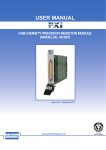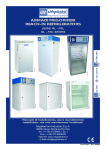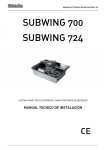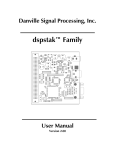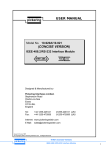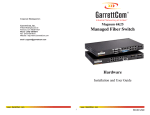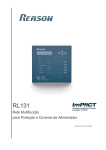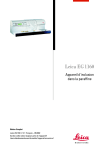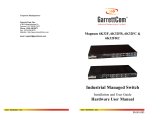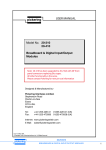Download Pickering 20-610 Manual
Transcript
USER MANUAL pickering Model No. 20-610 Very High Density Universal Multiplexer Designed & Manufactured by:Pickering Interfaces Limited. Stephenson Road Clacton-on-Sea Essex CO15 4NL England Tel: Fax: 01255-428141 01255-425349 +44 1255-428141 (International) +44 1255-425349 (International) Internet: www.pickeringswitch.com E Mail: [email protected] Issue 2 7/02 © Copyright (2002) Pickering Interfaces Ltd. All Rights Reserved pickering 20-610 VERY HIGH DENSITY UNIVERSAL MULTIPLEXER 1 HELP!!! If you need assistance with your Pickering Interfaces Switching System: Switching problems, Programming or Integration within your Test System. – Please ring Pickering Interfaces and ask for “Technical Support”. Alternatively you may fax, email or connect to our Internet Web Site. A full set of operating manuals, application notes and software drivers is available on CD ROM. 2 pickering 20-610 VERY HIGH DENSITY UNIVERSAL MULTIPLEXER Contents Section 1 Very High Density Universal Multiplexer .....................................................................5 Section 2 20-610 Operating Configurations and Expansion .......................................................9 Section 3 Self Test ....................................................................................................................13 Section 4 Programming ............................................................................................................15 Section 5 Connector Pin-Out Diagrams....................................................................................19 Section 6 20-610 Multiplexer PCB Layout ................................................................................37 pickering 20-610 VERY HIGH DENSITY UNIVERSAL MULTIPLEXER 3 4 pickering 20-610 VERY HIGH DENSITY UNIVERSAL MULTIPLEXER Section 1 Very High Density Universal Multiplexer 1.1 Features • Very High Density 352 Pin Multiplexer • Single, Dual or Quad Multiplexer Operation, Switching 1, 2, 4 or 8 Poles • Expandable to 10,000 Channels Using Internal Analogue Bus • Automatic Isolation Switches Reduce Capacitive Loading in Large Systems • High Quality Ruthenium Reed Relays For Maximum Reliability • Built-In Self Test • Suitable for Ribbon Cable Connection • Versatile Configuration Options: “One Module for ALL Your General Purpose Multiplexer Applications” • Lower Density 176 Pin Version Available The Universal Very High Density Multiplexer, Model 20-610, offers the highest density of any Pickering Multiplexer, with 352 switch pins. Configurable as a single, dual or quad multiplexer with a choice of 1, 2, 4 or 8 pole switching and is expandable to over 10,000 channels. 1.1 Description The 20-610 Universal 352 Pin Multiplexer Module is the first in a new generation of very high density multiplexers from Pickering Interfaces. One standard module offers a very large range of switching configurations plus extensive built in self-test. The 20-610 may be easily configured for most general purpose multiplexer requirements. Just by setting on-board links the unit may be configured as a single, dual or quad multiplexer with a choice of 1, 2, 4 or 8 pole operation (total of 18 configurations). The analogue common/s may be routed to the front panel or, for large system implementation, to one of the internal analogue buses. This versatility means that one multiplexer module is suitable for many different applications. For applications that require lower capacity a reduced density version, type 20-610-021, is available, this has 176 pins. Up to 2816 input channels can be accommodated in one System 20 Case, over 10,000 with multiple expansion cases. Built-in Automatic Isolation Switching connects only the currently active multiplexer switch bank, thereby keeping capacitive loading and leakage currents in large multiplexer systems to a minimum. For a summary of switching capabilities please refer to table 1.1. This is a double height module and must be mounted into a double height (6U) case. 1.2 Front Panel The module front panels comprise of three elements: Status Display, 4 LED Indicators:Power LED. Connected to power system supply. Active LED. On whenever one or more matrix switches are closed. For a list of all active switches use the VIEW? command. Warning LED. Indicates that an error may be soon be failing (relay contacts reaching end of life). Self-Test LED. Active when self-test in progress. Error LED. Indicates that error found during self-test. Serial (RS-232) Configuration/Test Port The 20-610 has a built in RS-232 port (9600 baud software handshake), this is used to configure the module and may also used for self test and error diagnosis (this may also be done using the normal IEEE-488/RS-232 interface). Connectors - suitable for ribbon cable connection Connection to the module front panel is via four 96 way DIN41612 connector plugs. Because of the large number of connections that may to be made to this module (up to 384) care must be taken with user connections. IDC type DIN41612 connectors may be used. Other connector types may be available, please contact sales office for further information. pickering 20-610 VERY HIGH DENSITY UNIVERSAL MULTIPLEXER 5 1 2 3 4 1 Common POW 2 3 351 ACT 352 4 TEST 1 Common 2 Bank 1 WARN Bank 2 Fig .1.1 Single MUX Mode: 44, 88, 176 or 352 Channels 3 351 1 1 352 4 2 3 Bank 1 Common 2 4 4 1 2 352 2 3 3 175 Common 2 176 Bank 1 4Bank Common 1 1 2 175 176 4 1 Bank 1 2 2 Bank 2 175 3 Bank 3 Bank 4 175 3 1 176Common 2 2 4 Common 1 3 Bank 2 1 Common 1 351 1 176 1 Bank 4 2 1 2 2 4 3 Bank 1 2 3 3 Bank 4 3 Bank4 4 3 Commo n4 Fig 1.2 Dual MUX Mode: 44, 88 or 176 Channels 1751 Commo n1 87 3 Commo n2 1 2 176 2 176 88 87 87 2 3 87 2 3 4 Commo n1 Commo n2 1 87 2 88 3 Commo n4 4 4 Commo n3 88 87 87 87 87 88 4 88 3 4 88 Bank 4 1 88 87 3 Commo 88 n4 4 Bank Commo 3n 3 1 88 2 87 3 88 4 1 2 87 3 4 Bank 2Commo n2 1 Commo n3 1 175 4 Bank 1 Commo n1 2 ERR 2 Common 88 88 Fig 1.3 Quad MUX Mode: 44 or 88 Channels Fig 1.4 20-610 Front Panel Module Illustration 1.3 Analogue Bus The analogue common can be routed (using internal jumpers) out to either the front panel connectors or the internal analogue bus. Routing to the front panel allows the user complete flexibility, routing to the internal analogue bus simplifies large system construction and ensures good signal isolation from external interference. The System 10/20 backplane features a shielded 24 pole analogue bus. This would be used with a multiplexer constructed using more than one module where the selected channel will be carried along the System 20 backplane analogue bus. The analogue bus can be brought out from the module in any of the following ways:1. The selected analogue common can be brought out on the front panel input connector. This also has the additional feature of keeping the analogue signal totally isolated from the backplane, improving crosstalk, dc leakage and low thermal emf performance. 2. Via a Breadboard module. Very useful if any signal conditioning, boosting etc. is to be done before bringing the signal out to the measuring device. 1.4 Width and Dimensions All modules conform to the 6U height (262mm) Eurocard standard and are 160mm deep. Panel width is 1.8 Inches. 6 pickering 20-610 VERY HIGH DENSITY UNIVERSAL MULTIPLEXER Switch Type Ruthenium Reed Max Standoff Voltage Max Power Max Switch Current Max Carry Current 100V 10W 0.5A 1.2A Path Resistance On (Single Module): Off (Single Module): Differential Thermal Offset 500mΩ (typical) > 109 Ω < 5µV Capacitance Open Channel Channel to Channel Crosstalk (Single Chan On, 50Ω) Channel to Channel 10kHz Channel to Channel 100kHz Channel to Channel 1MHz Bank to Bank 100kHz Bank to Bank 1MHz Bandwidth (3dB, 1 module) > 80dB > 65dB > 45dB > 80dB > 65dB > 5MHz Noise Level (0 to 1MHz in 50Ω System) < - 80dBm Max Operate Time Max Release Time Expected Life (Operations) Low power load Full power load 7ms 6ms < 6pF < 30pF > 108 > 5x106 † All the above specifications are for a complete 20-610 system consisting of eight multiplexers. Table 1.1 Switching Specification 1.5 20-610 Operating Modes Refer to Section 2 for further details. The 20-610-022 very high density multiplexer operates in all of the following modes:Quad Quad Dual Dual Dual 88 Channel 44 Channel 176 Channel 88 Channel 44 Channel 1 Pole Switching 2 Pole Switching 1 Pole Switching 2 Pole Switching 4 Pole Switching Single Single Single Single 352 Channel 176 Channel 88 Channel 44 Channel 1 Pole Switching 2 Pole Switching 4 Pole Switching 8 Pole Switching The 20-610-021 high density multiplexer operates in all of the following modes:Quad 44 Channel 1 Pole Switching Dual Dual 88 Channel 44 Channel 1 Pole Switching 2 Pole Switching Single Single Single 176 Channel 88 Channel 44 Channel 1 Pole Switching 2 Pole Switching 4 Pole Switching Analogue Common Connections Route Analogue Common to Front Panel Route Analogue Common to Internal Analogue Buses Expansion to multi case systems is achieved by choosing one module within each case and selecting the analogue bus to front panel configuration, the analogue bus commons are then simply daisy-chained to additional cases as required. Multi channel selection: Care must be taken when selecting many channels simultaneously not to overrate the power supply. pickering 20-610 VERY HIGH DENSITY UNIVERSAL MULTIPLEXER 7 20-610-022 352 Pin Multiplexer, Very High Density 20-610-021 176 Pin Multiplexer, High Density Suitable Mating Connectors: 10-967-001 96 Way DIN 41612 Socket (with Crimp Pins) 10-967-101 96 Way DIN 41612 IDC Socket 10-967-201 96 Way IDC Cable (1m, other lengths to order) Table 1.2 20-610 Product Order Codes 8 pickering 20-610 VERY HIGH DENSITY UNIVERSAL MULTIPLEXER Section 2 20-610 Operating Configurations and Expansion 2.1 Creating Larger Multiplexers When more than one module is used to make up a multiplexer – see diagram below, where seven modules are used to make up a 1232 channel 2 pole multiplexer – then all multiplexer units must have the same internal address, the location of each module within the multiplexer is given by its own bank address. Bank addresses must start at 0 and should be contiguous. If there is a problem with any of the modules used to make up a large multiplexer then an error will be detected (use the REPORT? query to discover the cause). Common Out Internal 24 Pole Analogue Bus Chan's: 1–176 2 Pole Bank 0 Chan's: 177–352 Chan's: 353–528 Chan's: 529-704 Chan's: 705-880 2 Pole 2 Pole 2 Pole 2 Pole Bank 1 Bank 2 Bank 3 Chan's: 881-1056 Chan's: 1057-1232 2 Pole 2 Pole Bank 4 Bank 6 Bank 5 Power Supply GPIB/RS-232 Interface Fig 2.1 20-610 Expansion Up to 8 Multiplexers can be housed per case, larger systems are formed using master/slave case expansion 20-610-022 20-610-022 20-610-022 20-610-022 20-610-022 20-610-022 20-610-022 20-610-022 Fig 2.2 Up to 8 x 20-610 Multiplexers Can Be Held In One Case (e.g. 2816 Channel 1 Pole) 2.2 Multiplexer Configurations The 20-610-022 very high density multiplexer operates in all of the following modes:- Table 2.1 20-610-022 Very High Density Configurations pickering 20-610 VERY HIGH DENSITY UNIVERSAL MULTIPLEXER 9 Table 2.2 20-610-021 High Density Configurations 10 pickering 20-610 VERY HIGH DENSITY UNIVERSAL MULTIPLEXER 1.4 2.1 88.1 1.1 1 1.2 1.1 Common Chan 44 1.1 Chan 1 1.2 Isolation Switch 2 Isolation Switch Bank 4 1.1 Bank 3 Common 2.2 44.2 3 88 Bank 4 (20-610-021 High Density Multiplexers have exactly half the capacity of the above versions). 1 2 Quad 44 Channel 2 Pole Fig 2.3 20-610-022 Very High Density Multiplexer Configurations pickering Isolation Switch 44.1 44.4 Dual 44 Channel 4 Pole Common Common Chan 44 Isolation Switches 1 2 2.1 44.3 3 88 1.2 44.2 1 44.2 2.4 44.1 3 88 Bank 2 2.2 44.1 1 2 2.1 Isolation Switches Common Chan 2 Bank 1 2.2 44.1 Bank 3 Single 44 Channel 8 Pole Common Common Isolation Switches 44.8 1.1 44.2 1.4 Chan 44 Common 44.7 44.1 44.2 1.1 2.3 44.4 44.6 44.4 2.2 44.3 44.5 Bank 2 2.1 44.2 2.2 2.1 1.3 44.1 Common Common Common Chan 1 Isolation Switches Chan 2 1.2 2.1 Isolation Switches 1.2 Common 88.2 1.2 Bank 2 2.8 88.1 Bank 1 2.4 44.3 2.6 2.7 1.1 2.1 44.2 2.5 Isolation Switches 1.1 44.1 2.4 2.2 Dual 88 Channel 2 Pole 1.4 Isolation Switches 2.2 2.3 2.1 Dual 176 Channel 1 Pole 2.3 2.1 1.2 176 2.2 1.6 1.8 Chan 2 Bank 2 Isolation Switches 1.3 1.5 1.7 3 1.2 1.4 Chan 1 88.1 2 Bank 1 1.3 88.2 1 Isolation Switch Single 88 Channel 4 Pole 1.1 176 Bank 2 88.4 2.2 Isolation Switches 3 Common Common 2 Isolation Switch 88.3 2.1 Common Bank 1 88.2 1.2 Bank 1 2.4 Chan 88 176.2 Single 176 Channel 2 Pole 2.3 Isolation Switches 176.1 352 Single 352 Channel 1 Pole 1.3 2.2 Common Common 2.1 2.2 Isolation Switches Isolation Switches 1.2 Common 3 1.1 1.2 Chan 1 2 1.1 Chan 2 1 Isolation Switch 3 88 Quad 88 Channel 1 Pole 20-610 VERY HIGH DENSITY UNIVERSAL MULTIPLEXER 11 Fig 2.4 20-610 Multiplexer Relay Layout Showing How Configuration Links Allow The 20-610 To Operate In Many Configurations 12 pickering 20-610 VERY HIGH DENSITY UNIVERSAL MULTIPLEXER Section 3 Self Test 3.1 Self-Test Function Self-Test is invoked at power on and may also be operated under software (*TST?) or via a recessed push button. Self-Test pass is indicated on a front panel LED with a full pass/fail description available using the DIAGNOSTIC? command. Self-Test comprises 2 levels, see Fig 3.1:1. Logic Test: Checks all logic including on-board microprocessor, relay drivers etc. 2. Relay Coil Test: All reed relay coils are checked for continuity. Note: Spare reed relays are mounted onto the relay circuit board for fast repair, additional reed relays are available from Pickering Interfaces. 3.2 Self-Test Operation Self Test is always run at power on. If self test is run under software control it will firstly clear the whole multiplexer (Manual Test will only function when the module is in a clear state). When the self-test has finished the multiplexer will be returned to an all clear state (i.e. the previous state will not be remembered!). Please note that because of the long self-test time that your computer may time out waiting for the test result (many PC's have default timeouts set to 10 seconds). 3.3 Detailed Self-Test Reporting using the DIAGNOSTIC? Query The DIAGNOSTIC? query will give an ASCII string detailing any self test failures. These will include:Logic: µP, RAM, EPROM, Relay Drivers, Invalid Link Settings etc. Relay Coils: Open Circuit Coil. This string is not intended to be processed by the user’s software, it is suitable for copying directly onto the screen of your control computer. This information will then indicate maintenance required (please contact Pickering for further help). Fig 3.1 610 Relay Contact Test (not implemented in current version) pickering 20-610 VERY HIGH DENSITY UNIVERSAL MULTIPLEXER 13 Fig 3.2 Self-Test: Basic Flow Diagram 14 pickering 20-610 VERY HIGH DENSITY UNIVERSAL MULTIPLEXER Section 4 Programming 4.1 Instruction Set The 20-610 Multiplexer module is simple to program:Open all channels on device a. Select channel c on multiplexer a, bank b. Multi-Channel selection argument s allows opening/closing of any combination of channels. Also allows selection of all channels except c (not available in 1 pole mode on very high density 20610-022). Force a minimum delay of t milliseconds between two instructions Report any Self Test errors. Open all switches on all modules View status of device a. ARESET a CHAN a,c CHAN a,b,c,s DELAY t DIAGNOSTIC? RESET VIEW? a The 20-610 module must be used in conjunction with the 10-921 or 20-910 interface module (it is not compatible with the older 10-920 interface). 4.2 Multiplexer Expansion Common Out Internal 24 Pole Analogue Bus Chan's: 1–176 2 Pole Bank 0 Chan's: 177–352 Chan's: 353–528 Chan's: 529-704 Chan's: 705-880 2 Pole 2 Pole 2 Pole 2 Pole Bank 1 Bank 2 Bank 3 Bank 4 Chan's: 881-1056 2 Pole Bank 5 Chan's: 1057-1232 2 Pole Bank 6 Fig 4.1 Configuring the Multiplexer System (all modules must have the same primary address) 4.3 Configuration Specific Programming Commands The 20-610 multiplexer module may be configured in one of the following modes:4.3.1 Quad/Dual Multiplexer Mode Each module contains four or two independent multiplexers (e.g.dual 176 channel or quad 44 channel), referred to as banks 1,2, 3 and 4: CHAN a,b,c Select channel c on bank b of multiplexer a. Only one channel at a time is permitted to be on, automatic break-before-make is always enforced. e.g. CHAN 3,1,34 will operate the module with address 3 selecting bank 1 channel 34. CHAN 15,2,1 will operate the module with address 15 selecting bank 2 channel 1. pickering 20-610 VERY HIGH DENSITY UNIVERSAL MULTIPLEXER 15 Fig 4.2 20-610 Multiplexer Module Instruction Set 16 pickering 20-610 VERY HIGH DENSITY UNIVERSAL MULTIPLEXER 4.3.2 Multiple Channel Selection (not allowed in 1 channel mode) To operate more than one channel at any time an extra enable/disable argument, s, must be added to the CHAN command. The command will allow any combination of channels to be selected (note: not available in single pole mode): Select channel c, if s = 1 (i.e. s <> 0) on bank b of multiplexer a. Deselect channel c, if s = 0, on multiplexer a. Please make particular note of the following points:CHAN a,b,c,s • When the multi-channel form of the CHAN command is used the automatic break-before-make operation of the multiplexer is disabled, it can only be enabled again by issuing a standard CHAN a,c command (this will first clear all selected channels on that multiplexer). • • Care must be taken not to inadvertently short any two signal source inputs together. • Multi-channel commands can not be used when in 1 pole mode, this is a limitation of the internal switching arrangement. The Isolation switches are always energised in multi-channel mode, therefore leakage resistance and stray capacitance will degrade. 4.4 Programming Examples Multiplexers are controlled using the CHAN and ARESET commands. The 20-640 series of multiplexers have two modes of operation:First, to check the size of the multiplexer at address 21. TYPE? 21 will return “MUX(2x176)”. A dual 176 channel multiplexer. To close channel 3 (bank 1) on multiplexer 21. CHAN 21,1,3 Now to look at status of multiplexer 21, bank 1. VIEW? 21,1 will return “3”. To clear bank 1. ARESET 21,1 Or to clear all banks. ARESET 21 Now to look at status. VIEW? 21,1 will return “0”. VIEW? 21 will return the status of all multiplexer banks. Note: This module must be used with the 10-921 IEEE-488/RS-232 Interface. pickering 20-610 VERY HIGH DENSITY UNIVERSAL MULTIPLEXER 17 18 pickering 20-610 VERY HIGH DENSITY UNIVERSAL MULTIPLEXER Section 5 Connector Pin-Out Diagrams The following pin out diagrams for the 20-610-022 very high density multiplexer are included:Quad Quad 88 Channel 44 Channel 1 Pole Switching 2 Pole Switching Dual Dual Dual 176 Channel 88 Channel 44 Channel 1 Pole Switching 2 Pole Switching 4 Pole Switching Single Single Single Single 352 Channel 176 Channel 88 Channel 44 Channel 1 Pole Switching 2 Pole Switching 4 Pole Switching 8 Pole Switching Blank DIN 41612 Connector Sheets are in Fig 5.16 and 5.17. Fig 5.1 Pin Out Diagram For Quad 88 Channel 1 Pole Mode pickering 20-610 VERY HIGH DENSITY UNIVERSAL MULTIPLEXER 19 Fig 5.2 Pin Out Diagram For Quad 44 Channel 2 Pole Mode 20 pickering 20-610 VERY HIGH DENSITY UNIVERSAL MULTIPLEXER Fig 5.3 Pin Out Diagram For Dual 176 Channel 1 Pole Mode pickering 20-610 VERY HIGH DENSITY UNIVERSAL MULTIPLEXER 21 Fig 5.4 Pin Out Diagram For Dual 88 Channel 2 Pole Mode 22 pickering 20-610 VERY HIGH DENSITY UNIVERSAL MULTIPLEXER Fig 5.5 Pin Out Diagram For Dual 44 Channel 4 Pole Mode pickering 20-610 VERY HIGH DENSITY UNIVERSAL MULTIPLEXER 23 Fig 5.6 Pin Out Diagram For Single 352 Channel 1 Pole Mode 24 pickering 20-610 VERY HIGH DENSITY UNIVERSAL MULTIPLEXER Fig 5.7 Pin Out Diagram For Single 176 Channel 2 Pole Mode pickering 20-610 VERY HIGH DENSITY UNIVERSAL MULTIPLEXER 25 Fig 5.8 Pin Out Diagram For Single 88 Channel 4 Pole Mode 26 pickering 20-610 VERY HIGH DENSITY UNIVERSAL MULTIPLEXER Fig 5.9 Pin Out Diagram For Single 44 Channel 8 Pole Mode pickering 20-610 VERY HIGH DENSITY UNIVERSAL MULTIPLEXER 27 The following pin out diagrams for the 20-610-021 high density multiplexer are Included:Quad 44 Channel 1 Pole Switching Dual Dual 88 Channel 44 Channel 1 Pole Switching 2 Pole Switching Single Single Single 176 Channel 88 Channel 44 Channel 1 Pole Switching 2 Pole Switching 4 Pole Switching Fig 5.10 Pin Out Diagram For Quad 44 Channel 1 Pole Mode 28 pickering 20-610 VERY HIGH DENSITY UNIVERSAL MULTIPLEXER Fig 5.11 Pin Out Diagram For Dual 88 Channel 1 Pole Mode pickering 20-610 VERY HIGH DENSITY UNIVERSAL MULTIPLEXER 29 Fig 5.12 Pin Out Diagram For Dual 44 Channel 2 Pole Mode 30 pickering 20-610 VERY HIGH DENSITY UNIVERSAL MULTIPLEXER Fig 5.13 Pin Out Diagram For Single 176 Channel 1 Pole Mode pickering 20-610 VERY HIGH DENSITY UNIVERSAL MULTIPLEXER 31 Fig 5.14 Pin Out Diagram For Single 88 Channel 2 Pole Mode (updated 5/97) 32 pickering 20-610 VERY HIGH DENSITY UNIVERSAL MULTIPLEXER Fig 5.15 Pin Out Diagram For Single 44 Channel 4 Pole Mode pickering 20-610 VERY HIGH DENSITY UNIVERSAL MULTIPLEXER 33 Fig 5.16 Blank Pin Out Diagram 34 pickering 20-610 VERY HIGH DENSITY UNIVERSAL MULTIPLEXER Fig 5.17 Blank Pin Out Diagram pickering 20-610 VERY HIGH DENSITY UNIVERSAL MULTIPLEXER 35 Internal Construction of 20-610 Module 36 pickering 20-610 VERY HIGH DENSITY UNIVERSAL MULTIPLEXER Section 6 20-610 Multiplexer PCB Layout BB24 BB23 BB22 1 C12 Lf4 Lp2 Lp11 C11 1 C13 C14 Lf3 U5 Lf7 RL184 U6 RL182 MUX Bank 4 RL183 RL176 Lp8 Lp7 BB21 BB20 BB19 Lp4 Lp12 Lf8 MUX Bank 2 RL181 RL88 RL175 RL87 BB18 BB17 BB16 BB15 BB14 BB13 BB12 BB11 BB10 Lr8 Lr7 Lr6 BB9 BB8 BB7 Lr5 Lr4 BB6 BB5 BB4 Lr3 Lr2 Lr1 BB3 BB2 BB1 J3 1 2 3 4 analogue bus access RL135 Lp9 Lp5 352 Pole Configurable Multiplexer RL134 Lp6 7 8 Lf2 Lp1 5 6 RL133 RL46 J6 1 C7 C8 RL47 J7 1 C9 C10 Lf1 RL45 Fx1 Lp3 Lp10 Lf6 U3 Lf5 U4 RL178 MUX Bank 3 RL180 RL132 RL131 RL90 RL89 MUX Bank 1 RL177 RL44 RL43 pickering RL179 A10 A9 A8 RL187 spare relays RL185 A3 A2 A1 RL186 spare / unused links A7 A6 A5 A4 1-A 2-A 2-A RL91 RL3 RL2 RL1 J5 + + 1 C3 C4 1 C5 C6 J4 J1 C1 C2 J2 U1 J8 U2 Fig 6.1 20-610 Relay PCB Layout (Top) pickering 20-610 VERY HIGH DENSITY UNIVERSAL MULTIPLEXER 37 Fig 6.2 20-610 Relay PCB Layout (Bottom) 38 pickering 20-610 VERY HIGH DENSITY UNIVERSAL MULTIPLEXER J4 J2 pickering J3 J1 Fig 6.3 20-610 Connection PCB Layout (Top) pickering 20-610 VERY HIGH DENSITY UNIVERSAL MULTIPLEXER 39 Fig 6.4 20-610 Connection PCB Layout (Bottom) 40 pickering 20-610 VERY HIGH DENSITY UNIVERSAL MULTIPLEXER PCB location PIL part number Part description Qty C1 C2 C3...C14 Fx1 " J1,J3 J2 J4,J6 J5,J7 J8 " RL1...RL176,RL186,RL187 RL177...RL185 U1...U6 config links " " C/CP/003 C/CP/003 C/CP/001 C/FX/130 C/FX/085 C/CN/001 C/CN/276 C/CN/285 C/CN/254 C/CN/128 C/CN/090 C/RL/073 C/RL/056 C/IC/035 C/CN/152 C/CN/156 Cap Tant 22uF 16V Cap Tant 22uF 16V Cap Cer 10nF 63V hex threaded spacer 16mm M3 washer DIN41612C r/a 64 way plg SIMM skt 72 way vertical DIN41612 straight 96 way pcb plg DIN41612C r/a 96 way plg 14 way mini-DIP transition 14 way IDC skt 109-2-A-12/2D 109-1-A-12/1D UCN5818EPF 32 bit driver smt pcb jack skt link 0.2" uninsulated omit 1 12 1 1 2 1 2 2 1 1 178 9 6 66 9 Table 6.1 GPIB145r0 PCB Parts-List PCB location PIL part number Part description Qty J1,J2 J3,J4 C/CN/267 C/CN/254 DIN41612 straight 96 way pcb skt DIN41612C r/a 96 way plg 2 2 Table 6.2 GPIB147r0 PCB Parts-List pickering 20-610 VERY HIGH DENSITY UNIVERSAL MULTIPLEXER 41 42 pickering 20-610 VERY HIGH DENSITY UNIVERSAL MULTIPLEXER











































